Food and Drink: Special Occasion Foods
National and Public Holidays
Songkran (Thai New Year)
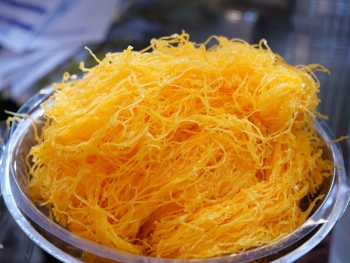
Marking the Thai New Year, Songkran is a three-day festival celebrated from April 13 to 15. It’s a time for water-splashing festivities, family reunions, temple visits, and sharing food. Traditional dishes such as khao chae (rice soaked in jasmine-scented water), som tam (spicy papaya salad), poh pia tod (egg rolls), and gaeng kiew wan (green curry) are popular. Sweets, including khanom tom (coconut rice balls), also are enjoyed. A common dessert at any Thai holiday meal is called foi thong meaning "golden threads." It consists of long, fine strands made of egg yolk cooked in a pandan-flavored sugar syrup. Golden threads are meant to bring good luck to those who eat them. They are often enjoyed stuffed inside roti (flatbread) with condensed milk and whipped cream. The food during Songkran reflects the themes of renewal and cooling off in the hot season, with meals shared among family and friends.
Chulalongkorn Day (King’s Birthday)
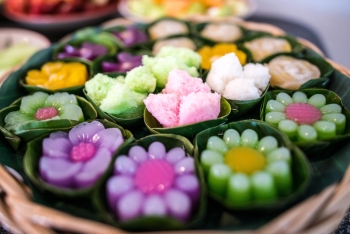
The King’s Birthday, celebrated on December 5, is a national holiday that honors the birthday of King Bhumibol Adulyadej, the ninth monarch of Chakri Dynasty and the longest-reigning monarch in Thailand's history. It is a time for community activities and charity, with many families preparing and sharing meals. Dishes such as pad Thai (stir-fried rice noodle dish), tom yum goong (spicy shrimp soup), and kai yang (grilled chicken) are common. Sweet offerings, including khanom chan (layered jelly-like dessert), are often made in the shape of flowers as a sign of respect. The food prepared for this occasion emphasizes tradition and national pride, with meals reflecting Thailand’s rich culinary heritage.
Religious and Spiritual Occasions
Loy Krathong
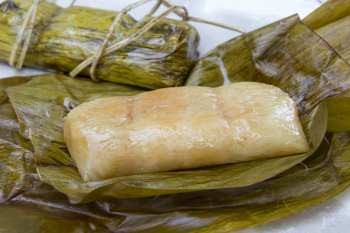
Loy Krathong, celebrated on the full moon of the 12th lunar month, involves floating decorative rafts on water to pay respect to the river goddess. The festival is known for its beautiful lantern displays and gatherings by the rivers. Traditional foods include khao tom mat (a mixture of sticky rice, banana, and coconut milk wrapped in banana leaves and steamed), pla plaa (grilled fish), and sweet treats such as khanom bueang (crepes filled with coconut). The food during Loy Krathong is often simple yet festive, reflecting the theme of gratitude and respect for nature.
Makha Bucha
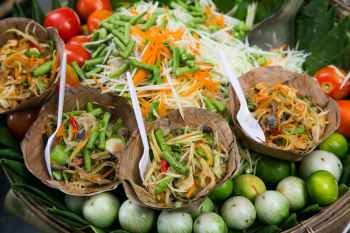
Observed with temple visits and offerings, Makha Bucha (or Magha Puja) is a Buddhist holiday celebrating the teachings of Buddha. The day is marked by vegetarian meals, as many Buddhists abstain from eating meat to honor the sanctity of the occasion. Common dishes include som tam (spicy papaya salad), tofu pad Thai (stir-fried rice noodle dish), and khao soi (curry noodle soup) without meat. Sweets such as thong yip (egg yolk desserts) also are shared among friends and family. The focus on vegetarianism reflects the spiritual nature of the day, with food embodying simplicity and respect for all life.
Life Milestones and Personal Celebrations
Weddings
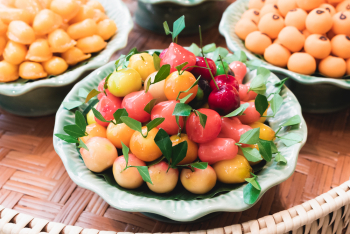
Thai weddings are elaborate and filled with symbolic rituals, where food plays a central role in the celebrations. The wedding feast often includes dishes such as gaeng phet (red curry), moo nam tok (spicy pork salad), and pla kapong neung manao (steamed fish with lime). Desserts, including khanom chan (layered jelly-like dessert) and luk chup (sweet mung bean paste shaped into fruits), are served as well. The food at Thai weddings symbolizes prosperity, happiness, and the union of families, with meals reflecting the rich flavors and traditions of Thai cuisine.
Thai custom requires a groom to bring sweets with symbolic meaning to his bride at their wedding. These sweets might include khanom tuay foo, a dessert made of puffed rice flour and food coloring; met khanoon, sweet mung beans and coconut cream; or khao neo dang, black sticky rice in the shape of a heart. These confections symbolize unity, luck, or love.
Birthdays
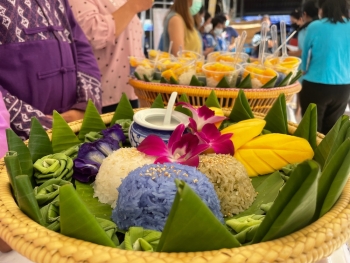
In Thailand, birthdays are celebrated with family gatherings, and the birthday person often makes merit by offering food to monks. A special birthday meal might include favorite dishes such as pad krapow (stir-fried basil chicken) and khao niew ma muang (mango sticky rice). Traditional desserts, including khanom bualoi (sweet rice flour dumplings in coconut milk), also are popular. The food at Thai birthday celebrations emphasizes gratitude and sharing, with meals that bring loved ones together in a spirit of joy.
Cultural and Regional Festivals
Tesagan Gin Je (Vegetarian Festival)

The Vegetarian Festival, taking place in October, is celebrated by Thailand’s Chinese community, focusing on purification through abstaining from meat. Street stalls offer a variety of vegetarian dishes such as je pad Thai (stir-fried rice noodle dish), mock meats, and noodle soups with tofu. Desserts such as woon ma plow (coconut jelly) and nam toa hua (soy milk) also are popular. The food during the festival is prepared without garlic or onion, aligning with the festival’s emphasis on purity and cleansing the body, and is enjoyed by both the Chinese community and the broader Thai population.
Phi Ta Khon Festival

The Phi Ta Khon Festival, taking place in the Isaan region, is known for its colorful masks and parades, celebrating local spirits. The festival’s food offerings include regional specialties such as som tam (spicy papaya salad), larb (spicy minced meat salad), and khao niao (sticky rice). Dishes are often prepared and shared among the community, with offerings made to the spirits. Sweet treats, including khanom krok (coconut pancakes), also are popular. The food during Phi Ta Khon reflects the local flavors of Isaan and the communal nature of the celebration, where meals are a way of honoring both ancestors and the present community.
Chak Phra (New Rice Festival)

Chak Phra is a harvest festival taking place in southern Thailand to celebrate the end of the rice season. It involves processions, boat races, and the sharing of freshly harvested rice. Traditional dishes such as khao yam (spicy rice salad with vegetables), pla rad prik (fried fish with chili sauce), and khao niao (sticky rice) are prepared. Sweet dishes, including sangkaya (custard in pumpkin), highlight the bounty of the harvest. The food during Chak Phra emphasizes gratitude for the rice harvest and the connection between the community and their land.
Phee Hom (Ghost Festival)
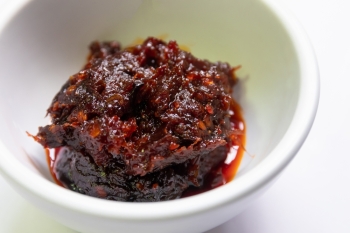
Phee Hom is a traditional festival celebrated in the north of Thailand, where locals honor the spirits of the deceased through rituals and offerings. Also known as the Ghost Festival, the event involves gathering and preparing special foods such as khao tom mat (a mixture of sticky rice, banana, and coconut milk wrapped in banana leaves and steamed), nam prik (a spicy chili sauce), and seasonal fruits. Food offerings are placed at shrines and shared among family members. The food during Phee Hom reflects both respect for the ancestors and the desire to share blessings, with meals that are an integral part of the rituals and communal gatherings.
Copyright © 1993—2025 World Trade Press. All rights reserved.

 Thailand
Thailand